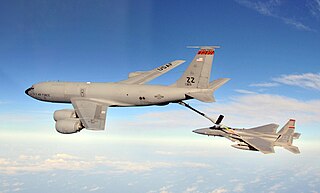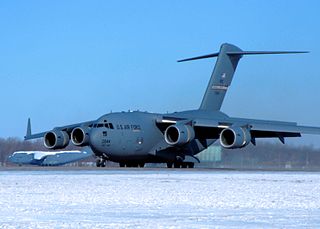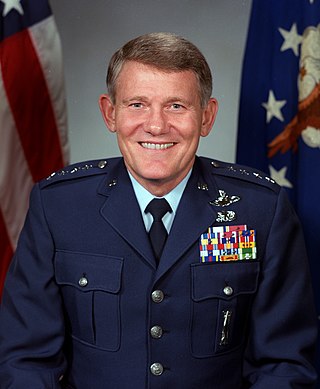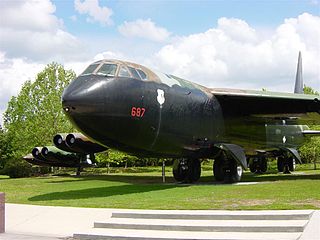
The Boeing KC-135 Stratotanker is an American military aerial refueling tanker aircraft that was developed from the Boeing 367-80 prototype, alongside the Boeing 707 airliner. It has a narrower fuselage and is shorter than the 707. Boeing gave the aircraft the internal designation of Model 717. The KC-135 was the United States Air Force's first jet-powered refueling tanker and replaced the KC-97 Stratofreighter. The KC-135 was initially tasked with refueling strategic bombers, but it was used extensively in the Vietnam War and later conflicts such as Operation Desert Storm to extend the range and endurance of US tactical fighters and bombers.

The OC-135B Open Skies is a United States Air Force observation aircraft that supports the Treaty on Open Skies. The aircraft, a modified WC-135B, flies unarmed observation flights over participating parties of the treaty. Three OC-135B aircraft were modified by the Aeronautical Systems Center's 4950th Test Wing at Wright-Patterson Air Force Base in Ohio. The first operationally-capable OC-135B was assigned to the 24th Reconnaissance Squadron at Offutt AFB in October 1993. It is now fitted with a basic set of navigational and sensor equipment, and was placed in inviolate storage at the Aerospace Maintenance and Regeneration Center at Davis-Monthan Air Force Base near Tucson, Arizona in 1997. Two fully operational OC-135B aircraft were delivered in 1996 with the full complement of treaty-allowed sensors, which includes an infrared line scanner, synthetic aperture radar and video scanning sensors.

The Boeing RC-135 is a family of large reconnaissance aircraft built by Boeing and modified by a number of companies, including General Dynamics, Lockheed, LTV, E-Systems, and L3 Technologies, and used by the United States Air Force and Royal Air Force to support theater and national level intelligence consumers with near real-time on-scene collection, analysis and dissemination capabilities.

Davis–Monthan Air Force Base is a United States Air Force base 5 miles southeast of downtown Tucson, Arizona. It was established in 1925 as Davis–Monthan Landing Field. The host unit for Davis–Monthan AFB is the 355th Wing assigned to Twelfth Air Force (12AF), part of Air Combat Command (ACC). The base is best known as the location of the Air Force Materiel Command's 309th Aerospace Maintenance and Regeneration Group, the aircraft boneyard for all excess military and U.S. government aircraft and aerospace vehicles.

Wright-Patterson Air Force Base (WPAFB) is a United States Air Force base and census-designated place just east of Dayton, Ohio, in Greene and Montgomery counties. It includes both Wright and Patterson Fields, which were originally Wilbur Wright Field and Fairfield Aviation General Supply Depot. Patterson Field is approximately 16 kilometres (10 mi) northeast of Dayton; Wright Field is approximately 8.0 kilometres (5 mi) northeast of Dayton.

The Boeing T-43 is a modified Boeing 737-200 that was used by the United States Air Force for training navigators, now known as USAF combat systems officers, from 1973 to 2010. Informally referred to as the Gator and "Flying Classroom", nineteen of these aircraft were delivered to the Air Training Command (ATC) at Mather Air Force Base, California during 1973 and 1974. Two additional aircraft were delivered to the Colorado Air National Guard at Buckley Air National Guard Base and Peterson Air Force Base, Colorado, in direct support of cadet air navigation training at the nearby U.S. Air Force Academy. Two T-43s were later converted to CT-43As in the early 1990s and transferred to Air Mobility Command (AMC) and United States Air Forces in Europe (USAFE), respectively, as executive transports. A third aircraft was also transferred to Air Force Materiel Command (AFMC) for use as the "Rat 55" radar test bed aircraft and was redesignated as an NT-43A. The T-43A was retired by the Air Education and Training Command (AETC) in 2010 after 37 years of service.

Hill Air Force Base is a major U.S. Air Force (USAF) base located in Davis County, Utah, just south of the city of Ogden, and bordering the Cities of Layton, Clearfield, Riverdale, Roy, and Sunset with its largest border immediately adjacent to Clearfield and Layton. It is about 30 miles (48 km) north of Salt Lake City. The base was named in honor of Major Ployer Peter Hill of the U.S. Army Air Corps, who died test-flying NX13372, the original Model 299 prototype of the B-17 Flying Fortress bomber. As of 2018 Hill AFB is the sixth-largest employer in the state of Utah. Hill AFB is the home of the Air Force Materiel Command's (AFMC) Ogden Air Logistics Complex (OO-ALC) which is the worldwide manager for a wide range of aircraft, engines, missiles, software, avionics, and accessories components. The OO-ALC is part of the Air Force Sustainment Center.

The WC-135 Constant Phoenix is a special-purpose aircraft derived from the Boeing C-135 Stratolifter and used by the United States Air Force. Its mission is to collect samples from the atmosphere for the purpose of detecting and identifying nuclear explosions. It is also informally referred to as the "weather bird" or "the sniffer" by workers on the program and international media respectively.

The Boeing C-135 Stratolifter is a transport aircraft derived from the prototype Boeing 367-80 jet airliner in the early 1950s. It has a narrower fuselage and is shorter than the 707. Boeing gave the aircraft the internal designation of Model 717. Since the first one was built in August 1956, the C-135 and its variants have been a fixture of the United States Air Force.

Hanscom Air Force Base (AFB) is a United States Air Force base located predominantly within Bedford, Massachusetts, with portions extending into the adjoining towns of Lincoln, Concord and Lexington. The facility is adjacent to Hanscom Field which provides general aviation and charter service.

Altus Air Force Base is a United States Air Force base located approximately 4 miles (6.4 km) east-northeast of Altus, Oklahoma.

Air Force Materiel Command (AFMC) is a major command (MAJCOM) of the United States Air Force (USAF). AFMC was created on July 1, 1992, through the amalgamation of the former Air Force Logistics Command (AFLC) and the former Air Force Systems Command (AFSC).

The 17th Training Wing is a United States Air Force unit assigned to the Air Education and Training Command Second Air Force. It is stationed at Goodfellow Air Force Base, Texas. The wing is also the host unit at Goodfellow. It was activated as a non-flying wing on 1 July 1993. Its mission is to train intelligence personnel in all the branches of the armed forces, as well as firefighters and a few other specialties. The wing trains Air Force enlisted intelligence, cryptology and linguist AFSCs 1N0, 1N1, 1N2, 1N3, 1N4, 1N5, 1A8, Air Force intelligence officer AFSC 14N, and military firefighters from all branches. Many corresponding Army, Navy, Space Force, and Marine Corps intelligence personnel are also trained at Goodfellow AFB, and assigned to the local units.

The Boeing EC-135 is a retired family of command and control aircraft derived from the Boeing C-135 Stratolifter. During the Cold War, the EC-135 was best known for being modified to perform the Looking Glass mission where one EC-135 was always airborne 24 hours a day to serve as flying command post for the Strategic Air Command in the event of nuclear war. Various other EC-135 aircraft sat on airborne and ground alert throughout the Cold War, with the last EC-135C being retired in 1998. The EC-135N variant served as the tracking aircraft for the Apollo program.

General Ronald Wilburn Yates served as Commander, Air Force Materiel Command, Wright-Patterson Air Force Base, Ohio. As AFMC Commander, Yates was responsible for research, development, test, acquisition and logistics support for the Air Force from 18 specialized centers and 116,000 military and civilian employees around the world.

The 306th Strategic Wing, previously the 306th Bombardment Wing, is an inactive United States Air Force unit. It was last assigned to the Strategic Air Command at RAF Mildenhall, Suffolk and was inactivated on 1 February 1992. The wing's mission was to coordinate all SAC air refueling and reconnaissance resources in the European Theater with the United States Air Forces in Europe (USAFE). It assumed the mission of the 98th Strategic Wing when that unit was inactivated in 1976.

General Raymond Edward Johns Jr. is a retired United States Air Force officer who served as Commander, Air Mobility Command.

Major General Jeffrey R. Riemer is a retired major general in the United States Air Force. He served as the program executive officer for the F-22 Program for the United States Air Force from January 2007 to October 1, 2008. During this time he was responsible for all acquisition activities including the awarding of a $5 billion contract extension for the procurement of an additional 60 aircraft. He previously served as commander of the Air Armament Center from December 2005 to January 2007.

Arnold Webster Bunch Jr. is a retired United States Air Force four-star general. He last served as the commander of Air Force Materiel Command, headquartered at Wright-Patterson Air Force Base, Ohio. He is responsible for installation and mission support, discovery and development, test and evaluation, life cycle management services and sustainment of virtually every major Air Force weapon system. The command employs approximately 80,000 people and manages $60 billion of budget authority annually. Before his current assignment, he was the military deputy in the Office of the Assistant Secretary of the Air Force for Acquisition at The Pentagon.




















